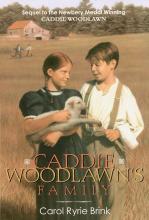Caddie Woodlawn is the story of a young tom-boyish girl who grew up in pioneer Wisconsin during the Civil War (this story predates the first book of the Little House series by about 25 years – but they are quite close geographically). Caddie's father was the grandson of an English Lord, but as his mother was from the lower classes, his father was disowned and the family grew up impoverished. He emigrated to America where he married a charming Boston lady with whom he raised a family of eight children. They moved to Wisconsin when Caddie (short for Caroline) was very young. Soon after their move and still before the story begins, they lost their five year old girl due to her sickly "constitution." Because of this, Caddie's parents decide to let her grow up in the out-of-doors where she spends a great deal of time adventuring in their nearby woods with her brothers. (This was quite uncommon for girls in those days.) There they meet real-life Indians and develop a curious friendship with them. They also hear somewhat wild Irish folktales from their golden-hearted Irish farmhand (you may want to read these tales yourself before presenting them to little ones), and are involved in a real-life "Incredible Journey" when their dog, Nero, amazingly returns to them after being lost several states away. Caddie's mother still does have an influence on her daughter and over the course of the story (in which Caddie is 11 years old) Caddie begins to develop a sense of what it means to be a lady, despite her rough ways. Like the Little House books, this story is neither Catholic nor particularly religious, but full of good old-fashioned family values and a proper devotion to parents – you particularly see the children's strong admiration for their father, who is simple, honest, hardworking, understanding, and plays a very active role in his children's daily lives.
The story is written by Caddie's granddaughter who, orphaned at a young age, was actually raised by Caddie and grew up listening to these stories from her grandmother's childhood. This grandmotherly wisdom shows through in the book in the way the stories were selected and told. Click or tap here for our review of Brink's second book, which contains more of the Woodlawns' adventures.
Our family recently enjoyed visiting Caddie Woodlawn Historic Park, near the Minnesota border in Western Wisconsin. It's a very simple place where you can walk through Caddie's house (no tourist guides or anything – you just walk through the empty house on your own) and visit a memorial to Caddie's sister Mary who is buried in an unknown place on the property. Reading this book (and visiting Caddie's house) were good opportunities for me as a mother to reflect on some of John Senior's ideas from the Restoration of Christian Culture on the benefits of a simpler life.
On a related note: I found the movie (of the same name) done by Wonderworks terribly disappointing. Most notably, they took one of my (and apparently the author's) favorite characters – the noble and loving Robert Ireton, and turned him into a mean and cowardly character.

